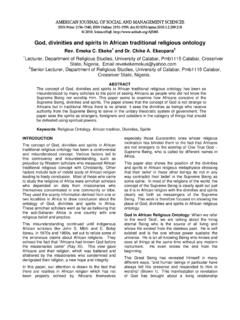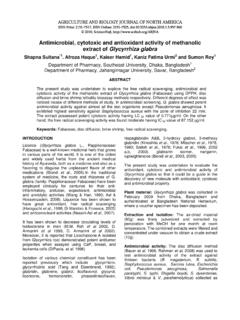Transcription of Influence of selected fungicides and hormone on the ...
1 AGRICULTURE AND BIOLOGY JOURNAL OF NORTH AMERICA ISSN Print: 2151-7517, ISSN Online: 2151-7525 2010, ScienceHu , Influence of selected fungicides and hormone on the rooting success of Shea (Vitellaria paradoxa gaernt) stem cuttings Yeboah, J., Akrofi, A. Y. and Owusu-Ansah, F Cocoa Research Institute of Ghana, Box 8, Tafo-Akim, Ghana ABSTRACT The sheanut tree (Vitellaria paradoxa Gaertn) is indigenous to the Guinea Savanna belt of West Africa extending from Senegal in the West to Sudan in the East. The tree s response to vegetative propagation methods is very poor and inconsistent.
2 Impact of different fungicides (Ridomil 72 plus, Dithane M45, Nordox 75 and Kocide 101), their different concentrations and frequencies of application and the application of a hormonal rooting powder (Seradix 3) were studied at Bole, Ghana from June to August, 2005. Significant rooting was observed when Dithane M45 was applied at 2000ppm three times (once every two weeks) during the rooting period and gave the highest rooting performance when combined with Seradix 3 hormone .
3 High concentrations of Dithane M45 did not significantly affect the degree of infection on cuttings. However, cuttings which were not sprayed with any fungicide recorded significantly (P< ) high fungal infection. Ridomil 72 Plus, Kocide 101and Nordox 75 lower rooting performance in shea cuttings. Keyword: Influence , Fungicide, Hormones, Sheanut tree Vitellaria paradoxa, rooting, Ghana INTRODUCTION Sheanut tree (Vitellaria paradoxa Gaertn) is one of the more frequently found species in the Guinea Savanna belt of West Africa extending from Senegal in the West to Sudan in the East (Dalziel, 1955).
4 It is recognized as a non-traditional export crop. Processed shea butter is known to have very good qualities and could act as a possible substitute for cocoa butter for manufacturing cosmetic products (Hall et al., 1996). It is appreciated for its skin healing and protective properties (Michael and Koffi, 2001). In Northern Ghana, the sheanut tree is the main source of livelihood to a large number of the populace (Irvine, 1961). Due to its importance to the inhabitants of the Northern part of Ghana, traditional laws have been enacted which make it a taboo to cut down the tree under any circumstance (Bolewura Amankwaa, personal communication).
5 Opoku-Ameyaw et al. (1996), working at Cocoa Research Institute of Ghana (CRIG) substation at Bole achieved little success using air layering with softwood ( ) and semi-hardwood ( ). Other trials performed at the same location showed that stem cuttings from coppiced sheanut trees had promising rooting ability (Opoku-Ameyaw et al., 2000). Currently, the development of effective propagation method that will facilitate the rapid multiplication of trees to meet increasing demand for planting materials is the main focus of CRIG s research activity.
6 Vegetative propagation methods vary with genetic constitution of the plant species (Nanda and Tandon, 1967), but success rate of most vegetative methods (grafting, budding, layering and cuttings) is low (Opoku-Ameyaw et al., 2000) and according to Hartmann et al., (1997), this may be improved by considering essential environmental and biochemical factors . A major cause for low success of vegetative propagation methods in shea is poor rooting of cuttings and this has hampered the establishment of shea plantations in Ghana.
7 Most of the cuttings suffer from fungal attack during the rooting process thus hampering rooting performance (personal observation). This paper reports on experiments conducted at the Cocoa Research Institute of Ghana substation at Bole in the Northern Ghana to establish reasons for the low and inconsistent propagation successes and to develop strategies to ensure successful propagation techniques which will facilitate rooting of cuttings of the sheanut tree.
8 MATERIALS AND METHODS Study Site: A series of experiments were carried out at the Cocoa Research Institute s substation at Bole in the Northern Region of Ghana in 2005. Bole is located within an altitudinal range of 100-600m with one rainfall maxima (600-1400mm) which occurs from May to September (Hall et al., 1996) and mean annual temperatures ranging from 25 to 29oC .The Northern Region falls within Guinea Savanna belt of West Africa. Agric. Biol. J. N. Am., 2010, 1(3): 313-320 314 Experiments were carried out in a polythene propagator made of a wooden frame and covered with a transparent polythene sheet.
9 The propagator, divided into apartments of m2 each was filled with layers of stones, gravels and sterilized rice husk rooting medium (Yeboah, 2005; Ofori-Gyamfi,1998) (Figure 1). Unless otherwise stated, the base of each shea cutting was dipped into 8000ppm Seradix 3 hormone (indolebutyricacid, indoleaceticacid and cytokinins) to a depth of m for five seconds, air-dried for 10sec and inserted into the rooting medium. Spacing between the cuttings was m. Fig 1: The polythene propagator used in the experiments showing arrangements of stones, gravels and growing medium.
10 Effects of fungicides and Seradix 3 hormone on rooting of shea stem cuttings: In this experiment, four types of fungicides , Dithane M45 (16% zinc; 3% manganese and ethylene), Ridomil 72 Plus (60% copper oxide; 12% metalaxyl), Nordox 75 (75% cuprous oxide) and Kocide 101 (77% copper hydroxide) and Seradix 3 hormone were assessed in a two factor factorial experiment in the randomized complete block design in July, 2004. Factor A was five different fungicides , whiles factor B was hormone .








![Welcome. [www.luxuryhotelcosmetics.com]](/cache/preview/9/6/e/c/8/2/0/0/thumb-96ec8200177466339b21692ed7d72c39.jpg)

